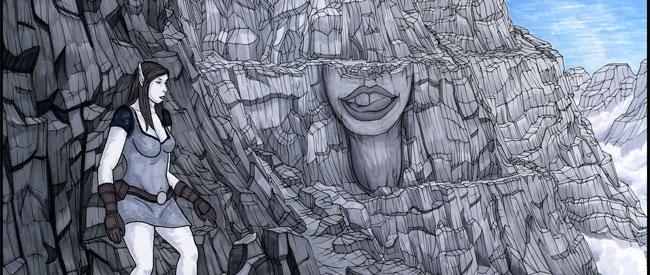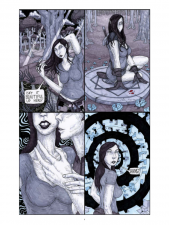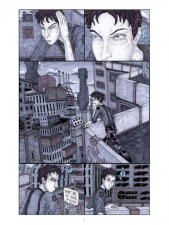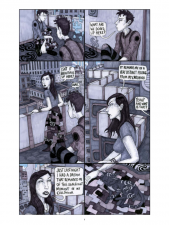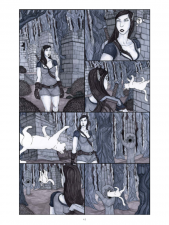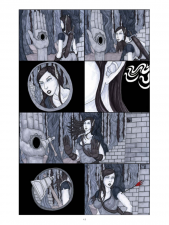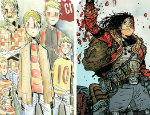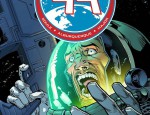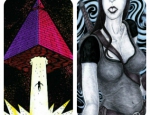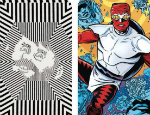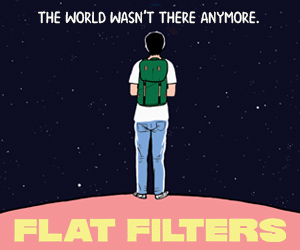In Dörfler, his debut graphic novel from Fantagraphics, Pittsburgh-based cartoonist Jeremy Baum scales up his familiar style and approach to create a hypnotic narrative that trips gaily along a tightrope over the abyss of obscurity.
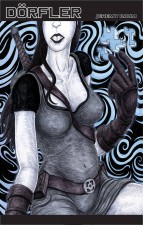 Given the way this complex book plays fast and loose with time, space and logic, it’s maybe easier to list some of its elements than to try and give a summary of the plot.
Given the way this complex book plays fast and loose with time, space and logic, it’s maybe easier to list some of its elements than to try and give a summary of the plot.
Dörfler centres on Nola, an inhabitant of an oppressive, walled-in future city. Recalling a vivid dream, she finds herself drawn into another version of herself – an elfin warrior-woman, questing her way through a series of epic landscapes.
The narrative then develops across the two locations. In the city, across a fragmented chronology, we meet two other women who share a mysterious past with Nola. ‘Meanwhile’, Nola’s alter ego tries to find her way into a fortified temple, toyed with along the way by mischievous, possibly malevolent and certainly sexually assertive female spirits. In a climax that matches the rest of the book for ambiguity, the two strands entwine.
However, if the sequence of events isn’t rolled out without ambiguity, then the thematic basis of the work seems clear enough.
On one side we have science, technology, modernity and patriarchal repression, epitomised by “Uncle Dave” (complete with phallic cigars) – a representation of the militarised regime that seemingly abducted the three women at the heart of the book and weaponised them into tools of repression.
On the other side is magic, nature, ancient power and the feminine spirit; when the establishment’s creations turn against them, a destructive reckoning is made. (Other dualities run through the book: the city versus the mountains; reality versus illusion; dreaming versus consciousness.)
Of course, when you tackle a book like this, you find yourself questioning your approach. Does every narrative need a logical progression and a cut-and-dried resolution? Some books in a similar vein, like Luke Ramsey’s Intelligent Sentient, move beyond the mechanics of storytelling to offer something more akin to a musical experience, providing something fresh each time you encounter them.
I’m not quite sure that kind of approach washes with Dörfler, which dangles too many of the apparent trappings of narrative to create that kind of immersive experience. As a result, even after a third reading, I was left with the feeling that I might have missed some key detail that would unlock the book – or thinking that maybe I’m just generally a bit thick for not ‘seeing’ it.
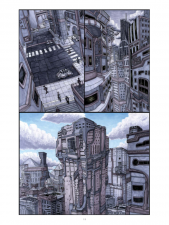 Anyway, the challenge of decoding Baum’s story makes it easy to overlook the style and beauty of his pages. Harnessing the power of a limited palette of blues and greys, he creates both arenas – city and mountains – with lovely graphic control. In a story dominated by female energy, Baum’s women also have a languid, liberated physicality.
Anyway, the challenge of decoding Baum’s story makes it easy to overlook the style and beauty of his pages. Harnessing the power of a limited palette of blues and greys, he creates both arenas – city and mountains – with lovely graphic control. In a story dominated by female energy, Baum’s women also have a languid, liberated physicality.
With its fluid reality, shifting identities and fugue states, Dörfler is probably most instantly reminiscent of the cinema of David Lynch (eg Lost Highway, Inland Empire, Mulholland Drive). However it also brings to mind Farel Dalrymple’s equally exhilarating and baffling comics opus The Wrenchies.
The deeply hypnagogic feel of Dörfler means that it certainly won’t be a book for everyone. However, the boldness of Baum’s approach and the rich texture of his craft make it worth a punt if you don’t mind finishing a piece of work with more questions than answers.
In summary: if you could handle The Wrenchies, you can probably handle this.
Jeremy Baum (W/A) • Fantagraphics Books, $22.99





